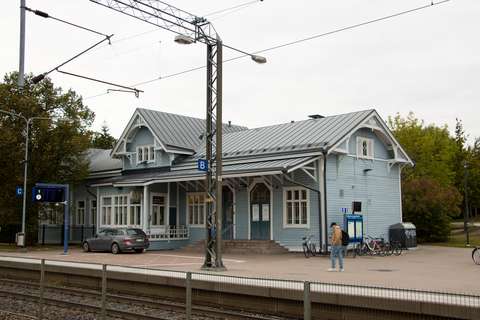Espoo Rail Line stations
On this page, you can find information about how each station and its surroundings will change as part of the Espoo Rail Line project and the related projects carried out by the City of Espoo.
During the Espoo Rail Line project, the accessibility of stations will be improved and park-and-ride facilities will be expanded. In connection with the construction of the two new tracks, the City of Espoo is carrying out several related projects, one of which is the Rantaradanbaana cycling and pedestrian route. In addition, connections from the stations to Rantaradanbaana will be built as well as new overpasses, which will improve the flow of pedestrian and bicycle traffic.
All the rebuilt stations will feature sheltered waiting areas with benches for passengers. When the Espoo Rail Line is completed, the northern tracks will primarily serve long-distance trains, while the southern tracks will serve commuter traffic.
Stations

As Espoo’s main railway station, Leppävaara is the key station in the Espoo Rail Line project. It is the third busiest transport hub in the capital region, offering fast and convenient connections by train, bus and light rail to all parts of the region. The light rail line running between Keilaniemi and Itäkeskus also provides a smooth connection to the metro. The long-distance trains that run between Helsinki and Turku stop at Leppävaara.
The Espoo Rail Line project will further increase Leppävaara’s attractiveness as a commercial centre and workplace area. The new rail line will significantly increase the demand for services in Leppävaara, especially from western and central Espoo: The Western Uusimaa Wellbeing Services County has decided to establish a health and social services centre in Leppävaara that will serve people from a larger area.
Improved public transport will also make Leppävaara a more appealing residential area, promoting investments and increasing population growth. This will boost housing construction and raise property values. Better transport connections can also increase cultural and recreational opportunities in the area, as accessibility improves and new services emerge.
At the western end of the Leppävaara station, the tracks will be slightly moved, which will also require minor adjustments to all platform edges. The three westernmost sections of the station’s northern parking area (located between the railway and Turuntie) will be moved further north, toward Turuntie. The surfacing and kerb lines of the parking area will be replaced, and due to the track shift, three parking spaces will be removed. A new street section, Säterinpuistontie (between Leppävaarankatu and Turuntie), will improve traffic flow and safety in the Leppävaara area.
Project page for Säterinpuistontie, Turuntie, Ratsukatu and Rakuunanpuisto.
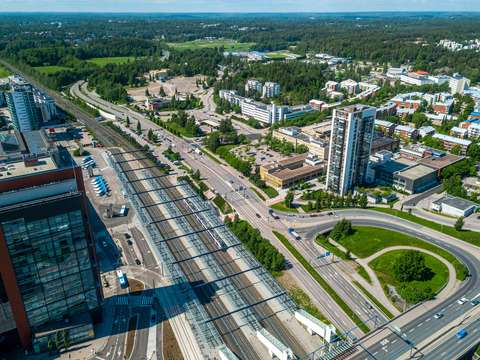

The new Espoo Rail Line tracks will be built north of the existing Kilo station. The island platform will be rebuilt, and it will include a ramp at one end. Commuter trains will use the two southernmost platforms. Access to the island platform will be via the station tunnel or Kilonkartanontie. The stairs leading to the southern side platform will be rebuilt, and a new accessible ramp will be constructed.
Parking at Kilo station
In the southern park-and-ride area, parking spaces will be reorganised and the kerb arrangement streamlined. The area will provide approximately 50 car parking spaces, 2 spaces for persons with reduced mobility, and about 90 bicycle parking spaces.
The street and traffic arrangements north of the station will also undergo some changes. The park-and-ride area located at the end of Kilonkuja will be moved by about ten metres, providing approximately 20 parking spaces. In the Kilontori and Kilonpolku areas, there will be around 200 bicycle parking spaces.
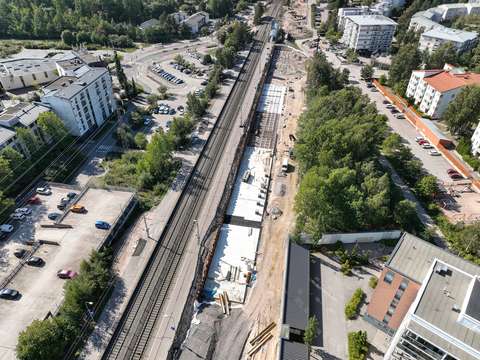

Kera is being developed into a new kind of residential district that promotes sustainable development, the circular economy and digitalisation, strongly supported by its excellent accessibility via the Espoo Rail Line. Formerly an industrial and logistics area, Kera will feature new housing and local services to meet residents’ daily needs. Other services will be available in Leppävaara and other district centres along the Espoo Rail Line. Several detailed plans are pending in Kera. The plan for the Kera centre has already entered into force. Together, the plans will enable the creation of a new residential area for approximately 16,000 inhabitants.
Kera station
Of the new tracks, one will be located south and one north of the existing tracks. A new platform will be constructed between the existing southern track and the new southern track, and the old side platforms will be demolished.
In a related project taking place later, a tunnel – Kerantunneli – will be constructed on the western side of the Kera station. A new pedestrian overpass will be built, providing access to the platforms. In the future, the platforms will also be accessible via the Dreijaportti underpass. The new track and platform have been designed so that the platform can be extended westward beyond Kerantunneli. Access to the platform will be via a temporary overpass with stairs and a lift.
Kerantunneli will later include light rail and bus stops. There will be an accessible route from the bus stops to the platform via lifts.
Parking
The location and design of the park-and-ride facilities will be specified as the component master plan and detailed plan for the area are finalised. According to the railway plan, there will be two park-and-ride areas on the south side of the tracks, along Kutojantie. These will feature about 180 car parking spaces and 200 bicycle parking spaces. On the north side of the tracks, also along Kutojantie, two additional areas will provide about 110 parking spaces.
There will be an accessible route from the park-and-ride area to the platforms via pedestrian paths and a lift.
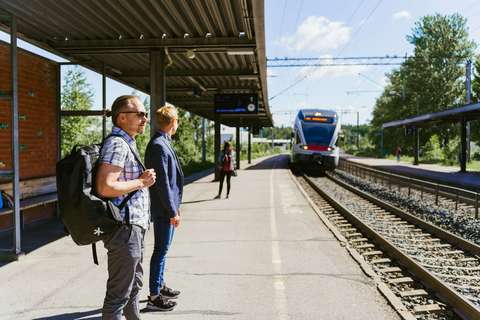

The second Espoo Rail Line area contract focuses on Kauniainen.
Espoo Rail Line on Kauniainen’s website (in Finnish)(external link, opens in a new window).

The new tracks will be built so that the new southern track is located south of the existing tracks, while the new central southern track will be near the current southern track. A new island platform will be built, and the old side platforms will no longer be used. Access to the platforms will be via an underpass.
Parking
A new park-and-ride area with around 110 car parking spaces will be built south of the station. On both sides of the Bredanportti street, there will be around 200 bicycle parking spaces. There will be accessible routes from the parking areas to the platform via lifts. A designated drop-off area for accessible taxis will be located at the bus stop next to the parking area.
Project page for the Koivuhovi park-and-ride area (in Finnish). https://www.espoo.fi/fi/hankkeet/koivuhovin-liityntapysakointi-bredanportti-ja-ullanmaentie
Espoo Rail Line on Kauniainen’s website (in Finnish)(external link, opens in a new window).
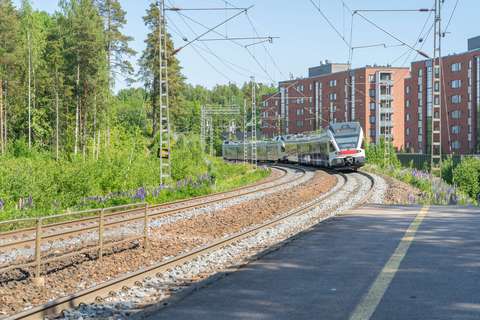

The new tracks will be positioned so that the new island platform will be built where the current tracks are located. The current side platforms will be demolished. Access to the island platform from Tuomarilanportti will be provided via a staircase and a lift.
As a related project, the City of Espoo will later build a roundabout at the intersection of Tuomarilantie and Tuomarilankatu. The carriageway, pedestrian and cycling routes, crossings, and bus stops will remain more or less in their current locations. They will be upgraded to meet current design standards through kerb arrangements.
Parking
The area will have about 40 car parking spaces. In the vicinity of the station, both north and south of the tracks, there will be a total of around 240 bicycle parking spaces. There will be an accessible route from the park-and-ride area to the platform via pedestrian paths and a lift. A designated drop-off area for accessible taxis will be located on Tuomarilantie, before the north-side bus stop.
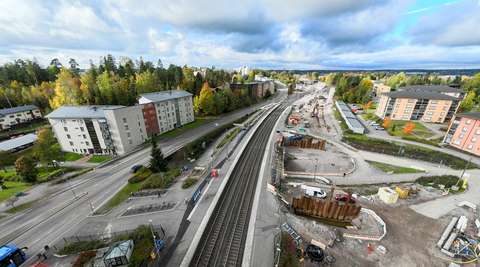

The range of services in Espoon keskus is expanding, which strengthens the area’s commercial appeal and vitality and reinforces its role among Espoo’s and the entire capital region’s urban centres. Projects being carried out in Espoon keskus focus on developing the station area and promoting residential construction close to services and public transport.
Public transport in Espoon keskus
There will be no major changes to the existing track or platform arrangements. All routes and connections to the platforms will remain as they are, and the platform shelters will also remain unchanged. However, in the future, public transport will be increasingly focused on the south side of the railway. As part of a related project to be carried out later, most bus routes passing through Espoon keskus will run via a new public transport terminal.
The terminal will include nine covered departure platforms, six arrival platforms and six short-term parking spaces. The aim is to make the transfer between different modes of transport as smooth as possible.
As a related project, a park-and-ride facility will be built in connection with the Espoontori shopping centre providing around 100 spaces for cars and around 150 spaces for bicycles. In addition, a waiting area for passengers will be constructed by the entrance.
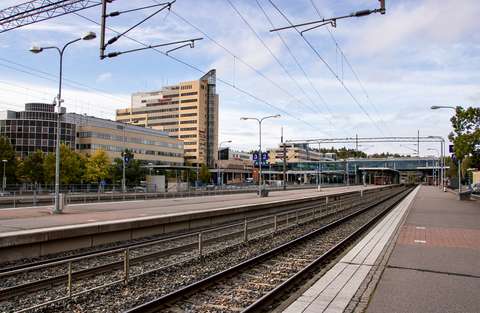

The fourth Espoo Rail Line area contract covers a rail section of approximately four kilometres, stretching from Espoon keskus to Kauklahti. Preparations for this stage will begin in autumn 2025.
The works will include track construction, ground reinforcement, and bridge construction at several sites, such as: the new Espoonjoki railway bridge, the Vadetinportti underpasses, the Vantinportti underpass, and the Kauppamäenkäytävä underpass, which will be located at the station. In addition, the contract includes modifications to the Kauklahti station area, the construction of Rantaradanbaana, and other street, railing and lighting works.
The industrial and warehouse area south of the Kauklahti station will be redeveloped by the City of Espoo into an urban district featuring housing, services, parks and a public transport terminal. On the north side of the tracks, park-and-ride facilities will be expanded, and the Kauklahti station building, which is part of a nationally significant built cultural environment, will be preserved. The detailed plan entered into force on 26 March 2025. You can find more information about the development of the Kauklahti station area here.
